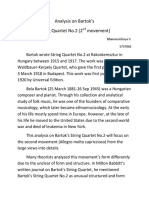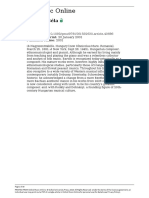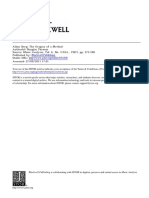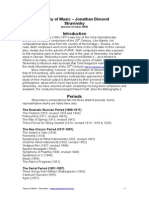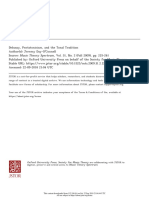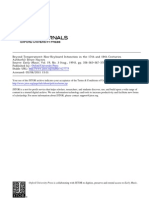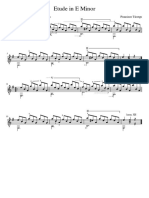BARTOK Music For Strings, Percussion, and Celesta - Analysis
BARTOK Music For Strings, Percussion, and Celesta - Analysis
Uploaded by
lourencobrCopyright:
Available Formats
BARTOK Music For Strings, Percussion, and Celesta - Analysis
BARTOK Music For Strings, Percussion, and Celesta - Analysis
Uploaded by
lourencobrOriginal Title
Copyright
Available Formats
Share this document
Did you find this document useful?
Is this content inappropriate?
Copyright:
Available Formats
BARTOK Music For Strings, Percussion, and Celesta - Analysis
BARTOK Music For Strings, Percussion, and Celesta - Analysis
Uploaded by
lourencobrCopyright:
Available Formats
Bartok.
Music for Strings Percussion, and Celesta
Page 1 of 3
MHL 341 Music History
Bartk, Bla: Music for Strings, Percussion, and Celesta, mvt. 1
l
The previous listening excerpt was Ives, Charles: Concord Sonata, mvt. 3, "The Alcotts". The first movement of MSPC (often pronounced Moose Pack) is a fugue. As you can see, it has frequent changes of meter, sometimes called variable meter, and also has irregular meters such as 5/8, 7/8, and 10/8, so that there is no apparent regular meter. There is no key signature, but the movement is centered on pitch class A, the pitch on which it begins and ends. The significant interval, however, is the tritone: A - E-flat. Note the long-line melody which, however, begins as a brief, 5-note germ motive that ascends a third and returns with different notes, then ascends again, growing to a tritone and returning. The third phrase is the climax phrase, followed by a fourth phrase before the Answer begins at m. 5. Even after the Answer, the original subject continues its independent way developing the germ motive with which it began. Meanwhile, you should be aware of the particular way in which the successive Subject and Entry pitches are arranged. The procedure is similar to a wedge in which the Subjects enter successively a fifth higher, thus A - E - B - F# (Gb) - C#(Db) - Ab - Eb, while the Answers enter successively a fifth lower, thus A - D - G - C - F - Bb - Eb. Thus there is a Subject or Answer on each of the 12 pitch classes and the climax of the piece is reached when the Subject and Answer both reach the tritone in opposite directions on Eb, m. 56. The wedge:
Eb Ab C#(Db) F#(Gb) B E A D G C F Bb Eb
Not all the entries are the same, but find them: A m. 1, E m. 4, D m. 9, B m. 12, G m. 16, (then several measure of working out the motive), F# m. 26, C m. 27, C# m.
10/15/2004
http://www.bayarea.net/~kins/AboutMe/Bartok/ASU_Reynolds/Bartok_MSCP.html
Bartok. Music for Strings Percussion, and Celesta
Page 2 of 3
28, F m. 33, Ab(G#) m. 35, Bb m. 37, Eb m. 44, leading to the dynamic climax on Eb m. 56 and reversing direction (and with some compression) returning via inverted intervals to the original pitch of A. This wedge begins in the lower string with an Eb entrance m. 56.
l
Another interesting section begins m. 77 where the melody begins in v. l. 1 and v. l. 4 simultaneously on pitch A, but in contrary motion, joined by the ostinato in the Celesta. Then in a kind of coda, the initial motive is played successively, m. 82, and in contrary motion in a duet wedge m. 86, ending on a unison A. Bartk employs in this movement only some of the techniques he learned from his study of real folk music: their use of irregular meter, their type of text setting or singing style which he called parlando-rubato, and the frequent use of 4ths and 2nd (and their inversions, fifths and 7th) in both melody and harmony that were different from the traditional European triadic harmony. Also, he used a kind of modal chromaticism in which the same mode or scale could include two notes of the same pitch class, such as F-sharp and F-natural (no church mode or major or minor scale uses two notes of the same name). Of course his music doesn't sound simple or folksy. It is, instead, a remarkable achievement. At this time in his life Bartk seems to have made a special effort to organize his music so that the constituent parts change or arrive at a climax, or have some sort of distinctive thing happening. The Golden Proportion or Section is based on the Fibonacci series of number, described DWMB2 p. 312. Since the measures are of different sizes in MSPC, you will be able to find the division by counting eighth notes and will find the Golden Proportion of the entire movement exactly at the climactic chord. Look for it. This movement may initially sound somewhat grim and mysterious. It is similar to several movements written by Bartk that are called "Night Music" pieces, in that they are the kind of music one might imagine at night. Not the pretty night music of Mozart's Eine kleine Nachtmusik (A Little Night Music), but rather the kind of frightening, nightmare music of more contemporary times. Such movements are usually the internal slow movements of his string quartets or symphonies, and are famous for the effects and new and unusual sounds he created. There are, by the way, four other movements to MSPC, the second and fourth of which are often said to be "Night Music." You should listen to the whole piece sometime. The next listening excerpt is Schoenberg, Arnold: Pierrot Lunaire, No. 8, "Nacht".
p. 477
#173, p. 286
4/11
513.1
MHL 341 Study Guide for K. Marie Stolba Brief Second Edition with Antholology, 2nd edition. [How to use MHL 341 Study Guide] [Medieval] [Renaissance] [Baroque]
http://www.bayarea.net/~kins/AboutMe/Bartok/ASU_Reynolds/Bartok_MSCP.html
10/15/2004
Bartok. Music for Strings Percussion, and Celesta
Page 3 of 3
[How to use MHL 342 Study Guide] [Classic] [Romantic] [20th Century] Return to First Page
http://www.bayarea.net/~kins/AboutMe/Bartok/ASU_Reynolds/Bartok_MSCP.html
10/15/2004
You might also like
- First Suite in Eb - Score (Large File) PDFDocument49 pagesFirst Suite in Eb - Score (Large File) PDFBkrnguy100% (2)
- Short Analysis of Debussy's Des Pas Sur La NeigeDocument6 pagesShort Analysis of Debussy's Des Pas Sur La NeigeGasoline-Rainbow71% (7)
- Analysis On Bartok String Quartet No.2 (Aj Thomas)Document7 pagesAnalysis On Bartok String Quartet No.2 (Aj Thomas)ปัณณวิชญ์ วัฒนศิริพงษ์100% (1)
- An Impressive Fugue - Analysis of The Fugue From Le Tombeau de Couperin by Maurice RavelDocument9 pagesAn Impressive Fugue - Analysis of The Fugue From Le Tombeau de Couperin by Maurice Ravelbenny100% (2)
- Debussy in Proportion A Musical Analysis-Roy Howat PDFDocument124 pagesDebussy in Proportion A Musical Analysis-Roy Howat PDFMartín García León100% (1)
- A Caplin-Style Analysis of Beethoven's Piano Sonata in C Major, Op. 2, No. 3, Movement IDocument23 pagesA Caplin-Style Analysis of Beethoven's Piano Sonata in C Major, Op. 2, No. 3, Movement ISilvestreBoulez100% (1)
- Dies Irae A Guide To Requiem MusicDocument730 pagesDies Irae A Guide To Requiem Musicbobjoeman100% (1)
- Webern's 5 Movements For String Quartet AnalysisDocument4 pagesWebern's 5 Movements For String Quartet AnalysisMichel Foucault100% (1)
- China Gates AnalysisDocument64 pagesChina Gates Analysiscarolina100% (1)
- Music Theory 1Document64 pagesMusic Theory 1Olena Afanasyeva100% (3)
- Anton Webern Four Pieces Op 7 Violin PianoDocument3 pagesAnton Webern Four Pieces Op 7 Violin Pianoledno_neuroNo ratings yet
- Requiem Für Einen Jungen DichterDocument3 pagesRequiem Für Einen Jungen DichterM. KorhonenNo ratings yet
- Analysis Schubert 5 PDFDocument33 pagesAnalysis Schubert 5 PDFUltimo De la FilaNo ratings yet
- Brahms 105-1 Analysis SymposiumDocument56 pagesBrahms 105-1 Analysis SymposiumVictoria Chang50% (2)
- Ornamentation in Baroque and Post-Baroque Music, with Special Emphasis on J.S. BachFrom EverandOrnamentation in Baroque and Post-Baroque Music, with Special Emphasis on J.S. BachNo ratings yet
- Wagner, Tristan Und Isolde, Prelude: AnalysisDocument2 pagesWagner, Tristan Und Isolde, Prelude: Analysis한세용100% (4)
- Webern Op7Document12 pagesWebern Op7siavooshNo ratings yet
- Jonathan Bernard VareseDocument26 pagesJonathan Bernard Vareseclementecolling100% (1)
- The String Quartets of Bela Bartok An Analysis PDFDocument185 pagesThe String Quartets of Bela Bartok An Analysis PDFBenjamin VidalNo ratings yet
- Schoenberg Piano Suite OP 25 AnalysisDocument4 pagesSchoenberg Piano Suite OP 25 AnalysisClayton Green100% (4)
- Hans Abrahamsen - Let Me Tell You (NOTES)Document2 pagesHans Abrahamsen - Let Me Tell You (NOTES)Jordan KerrNo ratings yet
- Brahms and The Variation CanonDocument23 pagesBrahms and The Variation Canonacaromc100% (1)
- Alex Burtzos Bach BWV 866Document12 pagesAlex Burtzos Bach BWV 866Tuna SenNo ratings yet
- Twelve-Tone Technique - WikipediaDocument12 pagesTwelve-Tone Technique - WikipediaAla2 PugaciovaNo ratings yet
- A. Webern - Drei Kleine Stucke, Op.11 No.1Document22 pagesA. Webern - Drei Kleine Stucke, Op.11 No.1renz_adameNo ratings yet
- Allusion as Narrative Premise in Brahms's Instrumental MusicFrom EverandAllusion as Narrative Premise in Brahms's Instrumental MusicNo ratings yet
- McCLARY, Susan (Ed.) - Structures of Feeling in Seventeenth-Century Cultural ExpressionDocument397 pagesMcCLARY, Susan (Ed.) - Structures of Feeling in Seventeenth-Century Cultural ExpressionRamiroGorriti100% (2)
- Book 1423444302 Rubank Advanced Method Trombone EducationalDocument3 pagesBook 1423444302 Rubank Advanced Method Trombone EducationalJoey Mercado0% (3)
- F.C.'s JigDocument9 pagesF.C.'s JigA100% (2)
- Bela Bartok S Concerto For OrchestraDocument43 pagesBela Bartok S Concerto For Orchestrasatch76No ratings yet
- Bélla Bartók Concerto For OrchestraDocument11 pagesBélla Bartók Concerto For OrchestraNick WiumNo ratings yet
- Bartok and Golden SectionDocument29 pagesBartok and Golden SectionRicardo J. Márquez Romero100% (1)
- SERIALISMDocument59 pagesSERIALISMCarlos Gutiérrez100% (7)
- A Guide To Bartóks Music For Strings Percussion and CelestaDocument4 pagesA Guide To Bartóks Music For Strings Percussion and CelestaAna Sincich100% (1)
- Franck-Variations Symphoniques For Piano and OrchestraDocument2 pagesFranck-Variations Symphoniques For Piano and OrchestraAlexandra MgzNo ratings yet
- Grove Music Online: Bartók, BélaDocument99 pagesGrove Music Online: Bartók, Bélaedition58No ratings yet
- Berio para EstudiarDocument6 pagesBerio para EstudiaragustinNo ratings yet
- Gillies (1995) Bartók Analysis and AuthenticityDocument10 pagesGillies (1995) Bartók Analysis and AuthenticityIma Bage100% (2)
- Takemitsu and ContemporariesDocument22 pagesTakemitsu and ContemporariesTe Wei Huang100% (1)
- Boynton-Some Remarks On Anton Webern's Variations, Op (2009)Document21 pagesBoynton-Some Remarks On Anton Webern's Variations, Op (2009)BrianMoseley100% (1)
- Symphony No. 5 Analysis PDFDocument3 pagesSymphony No. 5 Analysis PDFHamid Alipour ShiraziNo ratings yet
- Jarman Alban Berg The Origins of A Method PDFDocument17 pagesJarman Alban Berg The Origins of A Method PDFScott McGillNo ratings yet
- STRAVINSKY - Stylistic MusicDocument25 pagesSTRAVINSKY - Stylistic MusicspinalzoNo ratings yet
- Debussy, Pentatonicism, and The Tonal TraditionDocument38 pagesDebussy, Pentatonicism, and The Tonal TraditionMiguelÁngelTorresFrancoNo ratings yet
- Pierre Boulez's Le Marteau Sans MaîtreDocument7 pagesPierre Boulez's Le Marteau Sans MaîtreMidnighttosix100% (1)
- Mawer, Deborah - Historical Overview, French Music and Jazz in ConversationDocument27 pagesMawer, Deborah - Historical Overview, French Music and Jazz in ConversationKier ManimtimNo ratings yet
- Analysis of Chopin PreludeDocument68 pagesAnalysis of Chopin PreludeFletcher Fletcher100% (3)
- In Disguise: Borrowings in Elliott Carter's Early String QuartetsDocument8 pagesIn Disguise: Borrowings in Elliott Carter's Early String QuartetsMagritt100% (1)
- 480 12 Tone TechniqueDocument4 pages480 12 Tone TechniqueBenjamin NeldnerNo ratings yet
- Pierrot Lunaire - MondestrunkenDocument19 pagesPierrot Lunaire - MondestrunkenMarsé RomeroNo ratings yet
- Leon SteinDocument8 pagesLeon SteinAntoniWidjaja50% (2)
- Analysis of "Nicolette" (From Trois Chansons) by Maurice RavelDocument9 pagesAnalysis of "Nicolette" (From Trois Chansons) by Maurice RavelChristopher HärtelNo ratings yet
- Stravinsky - Van Den ToornDocument42 pagesStravinsky - Van Den Toornmao2010100% (1)
- Once More "Between Absolute and Program Music": Schumann's Second SymphonyDocument19 pagesOnce More "Between Absolute and Program Music": Schumann's Second SymphonyJMKrausNo ratings yet
- Bartok's Music For Strings, Percussion and CelesteDocument16 pagesBartok's Music For Strings, Percussion and CelesteWolfgang SalazarNo ratings yet
- StravinskyDocument13 pagesStravinskyharneyrp100% (2)
- Transformations in Music Theory and MusiDocument13 pagesTransformations in Music Theory and MusiAntonio Peña FernándezNo ratings yet
- Musical Direction and The Wedge in Beethoven's High Comedy, Grosse Fuge Op.133Document15 pagesMusical Direction and The Wedge in Beethoven's High Comedy, Grosse Fuge Op.133João Corrêa100% (1)
- Bartok's Musical Influence On Chinese ComposersDocument8 pagesBartok's Musical Influence On Chinese ComposersJoshua ChungNo ratings yet
- Bartók On His Own MusicDocument13 pagesBartók On His Own Musicr-c-a-d100% (2)
- A Conductor's Analytical Study of Vincent Persichetti's Symphony For Band (Symphony No.6) Op. 69 - Michael W. ChesterDocument183 pagesA Conductor's Analytical Study of Vincent Persichetti's Symphony For Band (Symphony No.6) Op. 69 - Michael W. Chestermcheste290% (10)
- Beyond Temperament - Non-Keyboard Intonation in The 17th and 18th Centuries (Bruce Haynes)Document25 pagesBeyond Temperament - Non-Keyboard Intonation in The 17th and 18th Centuries (Bruce Haynes)Thomas Patteson100% (2)
- Poulenc Revision SheetDocument5 pagesPoulenc Revision Sheetapi-278319614No ratings yet
- Serial Music: A Classified Bibliography of Writings on Twelve-Tone and Electronic MusicFrom EverandSerial Music: A Classified Bibliography of Writings on Twelve-Tone and Electronic MusicNo ratings yet
- The Secular Commedia: Comic Mimesis in Late Eighteenth-Century MusicFrom EverandThe Secular Commedia: Comic Mimesis in Late Eighteenth-Century MusicNo ratings yet
- Stars and Stripes: J.P. SousaDocument23 pagesStars and Stripes: J.P. SousaAntonio FilhoNo ratings yet
- Jens Larsen: Dm7 G7 Cmaj7 Dm7 G7 Cmaj7 G7 ( 9 5)Document3 pagesJens Larsen: Dm7 G7 Cmaj7 Dm7 G7 Cmaj7 G7 ( 9 5)sinjivaiNo ratings yet
- 5.2 MWD - Diatonic Triads - Minor (Answers)Document3 pages5.2 MWD - Diatonic Triads - Minor (Answers)Mathias De RidderNo ratings yet
- 2nd Q - M1-Music (Post Test) 2Document6 pages2nd Q - M1-Music (Post Test) 2FO VCNo ratings yet
- A Jazz Pianists Guide To Rhythmic Independence Through Afro Cuban RhythmsDocument152 pagesA Jazz Pianists Guide To Rhythmic Independence Through Afro Cuban RhythmsTropiCool100% (11)
- Jack Tyerman Statement of AimsDocument13 pagesJack Tyerman Statement of Aimsapi-630394123No ratings yet
- Some Notes On Stravinsky's Requiem Settings PDFDocument27 pagesSome Notes On Stravinsky's Requiem Settings PDFmoonwhite100% (1)
- Lean On Me Lyrics (Sol-Fa)Document4 pagesLean On Me Lyrics (Sol-Fa)Shola Able-ThomasNo ratings yet
- Wedding March - CelloDocument1 pageWedding March - Cellodeny setiawanNo ratings yet
- Shivers Ed Sheeran Shivers Ed Sheeran MixedDocument1 pageShivers Ed Sheeran Shivers Ed Sheeran MixedMaikon Catita ViolinistaNo ratings yet
- ErlkonigDocument5 pagesErlkonigapi-269751528100% (1)
- Flauta Baixo DedilhadoDocument9 pagesFlauta Baixo DedilhadospindolaNo ratings yet
- WHLP g9 Mapeh 3rd QuarterDocument6 pagesWHLP g9 Mapeh 3rd QuarterDianne PadillaNo ratings yet
- CRAZY by AerosmithDocument58 pagesCRAZY by AerosmithDiego FuentesNo ratings yet
- Chamber Music I Syllabus 2020 (5) - 1Document5 pagesChamber Music I Syllabus 2020 (5) - 1Matthew SuhNo ratings yet
- BBI Trinity Exams BookDocument75 pagesBBI Trinity Exams Bookgema caceresNo ratings yet
- Tarrega Study in E MinorDocument1 pageTarrega Study in E MinorAnderson ReisNo ratings yet
- Prepare 6Document5 pagesPrepare 6Tarik KouradNo ratings yet
- Do You Really Know The Pentatonic Scale PDFDocument3 pagesDo You Really Know The Pentatonic Scale PDFRosa victoria paredes wongNo ratings yet
- The Mainsprings of Russian Music Folk Song and Religious ChantDocument6 pagesThe Mainsprings of Russian Music Folk Song and Religious ChantHelena RadziwiłłNo ratings yet
- Maria Elena ScoreDocument16 pagesMaria Elena ScoresalcevedoNo ratings yet
- 12.sinif Ingilizce Yillik Plan 2023 2024 IndirDocument6 pages12.sinif Ingilizce Yillik Plan 2023 2024 IndirfckepenekNo ratings yet
- The Official UK Singles Chart December 2004Document22 pagesThe Official UK Singles Chart December 2004Randy MartinsNo ratings yet
- Seleção Natalina - Full ScoreDocument64 pagesSeleção Natalina - Full ScoreRenato Araújo100% (1)


